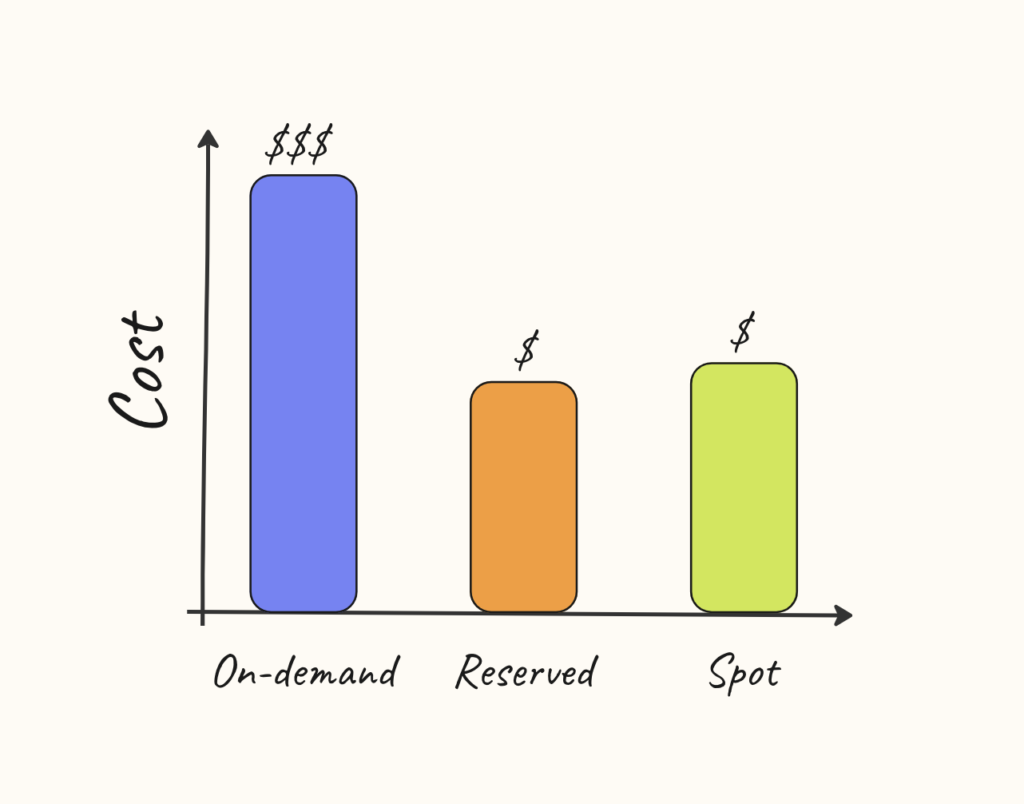Managing cloud costs is a critical task for companies that rely on AWS EC2 to support their operations. One way to reduce costs is by optimizing the type of instances used for different workloads. In this post I’ll focus on AWS EC2 and compare the advantages and disadvantages of on-demand, reserved, and spot instances to help you understand how each option can impact your bottom line.
On-Demand Instances
On-demand instances are the most flexible option available in AWS EC2, allowing you to spin up or down resources as needed. However, this flexibility comes at a cost. You pay for each instance by the hour, with no upfront payment or commitment required. This can lead to unexpected bills if usage patterns change or if a project runs longer than anticipated.
Advantages:
- No upfront commitment
- Pay only for what you use
- Flexibility to scale up or down as needed
Disadvantages:
- Higher hourly cost than reserved or spot instances
- Potential for unexpected bills if usage patterns change
Reserved Instances
Reserved instances offer significant cost savings over on-demand instances, with the trade-off being a longer commitment to the service. With reserved instances, you pay an upfront fee for a specific instance type for a one- or three-year term. In exchange, you receive a significant discount on the hourly rate for that instance.
For example, let’s say you need 100 m6g.large instances for your application. On-demand pricing for this instance type is currently $0.077 per hour. If you were to run these instances for a full year, the total cost would be $67,452. However, if you were to purchase a one-year reserved instance, the hourly rate drops to $0.045, resulting in a total cost of $39,508 – a savings of $27,944 or 41.5%.
Advantages:
- Lower hourly cost than on-demand instances
- Upfront payment can lead to predictable costs
- Can purchase reserved instances for a one- or three-year term
Disadvantages:
- Longer commitment to the service
- Limited flexibility to change instance types or scale up or down
Spot Instances
Spot instances are a way to bid on spare Amazon EC2 capacity, which may offer even lower prices than reserved instances. However, there is no guarantee of availability and the instances can be terminated at any time if the spot price increases above your bid. This makes spot instances a good option for workloads that can be interrupted, such as batch processing or testing.
For example, let’s say you have a batch processing job that you want to allocate resources to. On-demand pricing for a m6g.large instance is currently $0.077 per hour. However, the current spot price for the same instance is $0.024 per hour. If you were to run this job on a spot instance, you would get a savings of 68.8%.
Advantages:
- Significant lower hourly cost than on-demand instances
- A good option for workloads that can be interrupted
- Can use spot instances as cost-effective resources for testing environments
Disadvantages:
- No guarantee of availability
- Instances can be terminated at any time if the spot price increases above your bid
- Might not be suitable for critical production workloads
- The cost is fluctuating and can be unpredictable, realistically the average saving over time is around is 50%-60% compared to on-demand instances
Summary

| Instance Type | Hourly rate | # of instances | Total cost for 1 year | Savings |
|---|---|---|---|---|
| On-demand | $0.077 | 100 | $67,452 | – |
| Reserved (1 year) | $0.045 | 100 | $39,508 | $27,944 (41.5%) |
| Reserved (3 years) | $0.028 | 100 | $25,400 | $42,052 (62.3%) |
| Spot | $0.024 | 100 | $2.88 | $21048 (68.8%) |
When it comes to AWS EC2 cost management, it’s important to consider the specific needs of your workloads and business. On-demand instances offer the most flexibility, but come at a higher cost. Reserved instances can provide significant savings over time, but require a longer commitment. Spot instances offer low hourly costs but come with the risk of interruption.
By understanding the advantages and disadvantages of each option, you can make informed decisions that can lead to cost savings for your organization. It’s also important to note that this is just the tip of the iceberg when it comes to cloud cost optimization. There are many other techniques like auto-scaling, rightsizing, and using reserved instances that can help you to optimize your cloud costs further.



